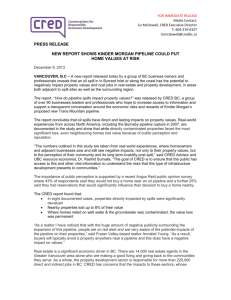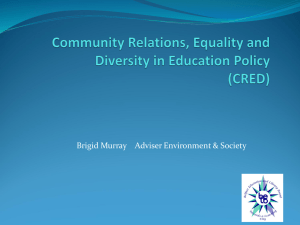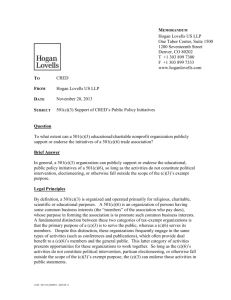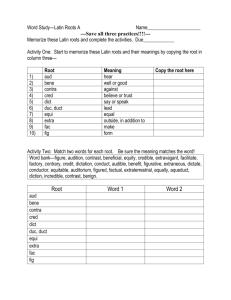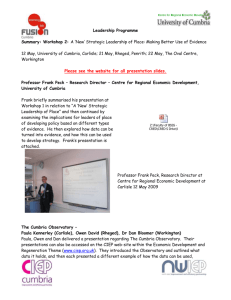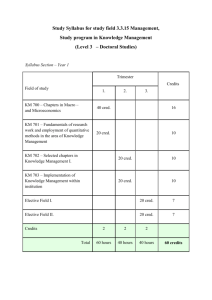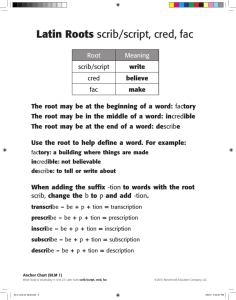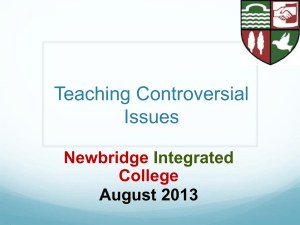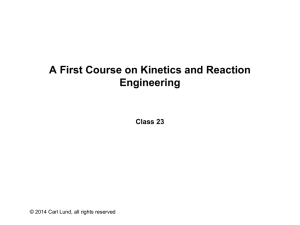A Common Bond - Center for Research on Environmental Decisions
advertisement
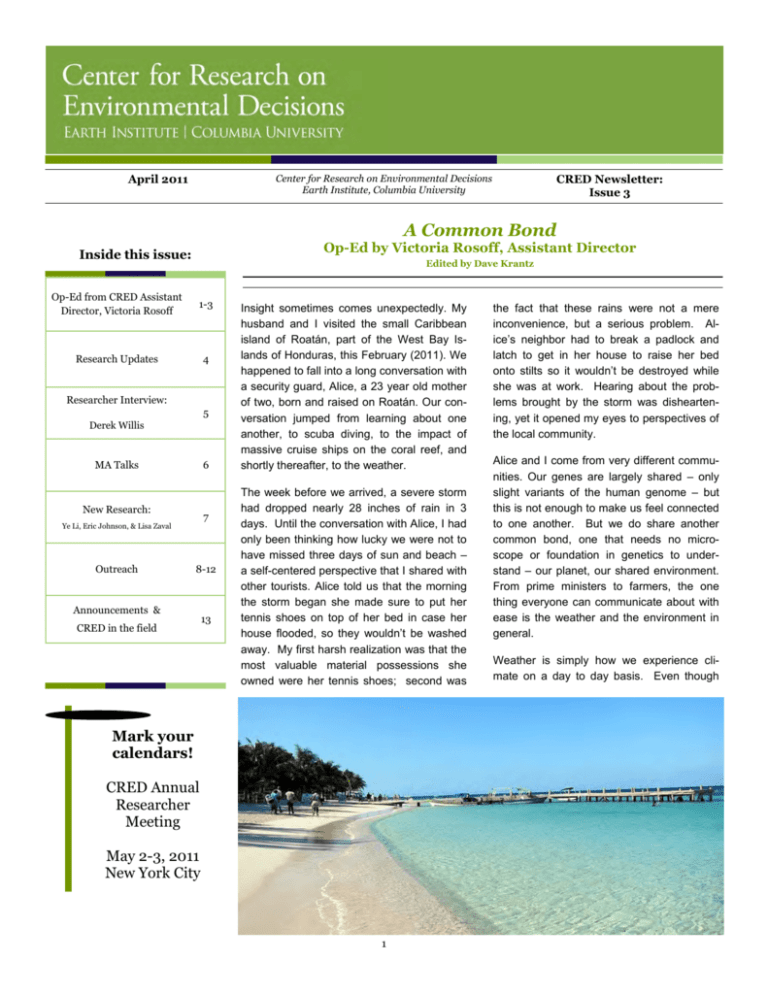
Center for Research on Environmental Decisions Earth Institute, Columbia University April 2011 CRED Newsletter: Issue 3 A Common Bond Op-Ed by Victoria Rosoff, Assistant Director Inside this issue: Edited by Dave Krantz Op-Ed from CRED Assistant Director, Victoria Rosoff 1-3 Research Updates 4 Researcher Interview: 5 Derek Willis MA Talks 6 New Research: 7 Ye Li, Eric Johnson, & Lisa Zaval Outreach 8-12 Announcements & CRED in the field 13 Insight sometimes comes unexpectedly. My husband and I visited the small Caribbean island of Roatán, part of the West Bay Islands of Honduras, this February (2011). We happened to fall into a long conversation with a security guard, Alice, a 23 year old mother of two, born and raised on Roatán. Our conversation jumped from learning about one another, to scuba diving, to the impact of massive cruise ships on the coral reef, and shortly thereafter, to the weather. The week before we arrived, a severe storm had dropped nearly 28 inches of rain in 3 days. Until the conversation with Alice, I had only been thinking how lucky we were not to have missed three days of sun and beach – a self-centered perspective that I shared with other tourists. Alice told us that the morning the storm began she made sure to put her tennis shoes on top of her bed in case her house flooded, so they wouldn’t be washed away. My first harsh realization was that the most valuable material possessions she owned were her tennis shoes; second was Mark your calendars! CRED Annual Researcher Meeting May 2-3, 2011 New York City 1 the fact that these rains were not a mere inconvenience, but a serious problem. Alice’s neighbor had to break a padlock and latch to get in her house to raise her bed onto stilts so it wouldn’t be destroyed while she was at work. Hearing about the problems brought by the storm was disheartening, yet it opened my eyes to perspectives of the local community. Alice and I come from very different communities. Our genes are largely shared – only slight variants of the human genome – but this is not enough to make us feel connected to one another. But we do share another common bond, one that needs no microscope or foundation in genetics to understand – our planet, our shared environment. From prime ministers to farmers, the one thing everyone can communicate about with ease is the weather and the environment in general. Weather is simply how we experience climate on a day to day basis. Even though CRED Newsletter Page 2 others in their neighborhood or school, but even so, kids mainly communicate with people in their already existing networks. In low-income areas, some kids don’t even have access to this technology and are confined to a smaller bubble. Kids are exposed to science in school, and to the news of extreme weather events from television, but rarely do they get to talk directly to age-mates from different parts of the world to get first-hand accounts of major events. climate is, in the most simplified terms, just the average weather over time in a particular place, weather is what we actually pay attention to. We do not experience climate in the immediate sense, and much less do we notice changes in our climate on a day to day basis. Focusing on the everyday expressions of climate through weather events may encourage otherwise disengaged people to engage in discourse about climate change. That said, the specific weather event that sparked my conversation with Alice might or might not have been related to climate change. Either way, discussions about mitigation and adaptation to extreme weather events are engaging and relevant. We could bridge this gap by developing a website where kids from around the world can tell their own stories about weather events or environmental issues in their area and discuss how they are impacted by them. They could do this in the form of essays, poems, photos, drawings, twitter-length postings, etc., sharing these with other kids from across the globe. The website could be called ―The Common Bond‖ or ―Kids Village Green‖ (other suggestions for names are welcome). We could start this in classrooms that we already work with and then connect with other schools. In low-income schools, we could seek funding for computers to be distributed to classrooms so that kids could logon to the website from school and share their stories. The main goals of the website would be to serve as an educational platform and as a communication tool. The next Talking with Alice made the idea of shared experience much more vivid, and it also planted the seed of an outreach idea that could reach a segment of the population that does not usually have a chance to venture outside their immediate surroundings. As assistant director of CRED, I have had the chance to work on outreach, with one particular focus being outreach at the high school level. Up until now, we have not devoted much effort to younger grade levels. I think it would be of great value to increase our outreach to children. Kids are often sheltered, closed off from the world outside of their small bubbles. Facebook and other social sites have helped connect children to 2 CRED Newsletter Page 3 goal down the road for this project would be for kids to share their ideas for mitigation and adaptation to climate change and specifically to weather events in their hometowns. Kids from other regions could chime in with their opinions on those ideas and we could even put out an annual publication that features outstanding contributions to the website during the past year. Kids could develop early warning systems for their neighborhoods, create evacuation plans for their schools, and come up with all sorts of ingenious ideas to deal with the problems that they contend with every day. The site could also serve an additional function as a forum for kids to pose questions to CRED researchers and for CRED researchers to chime in with their own anecdotes from the field. In the future, this website could be used as a data source for CRED researchers wanting to conduct surveys on this particular age group and it would remain as a historical database for future generations to learn more about people’s perceptions and reactions to past weather events and environmental issues. all they know? Can you imagine how much more salient climate issues may be if a 15 year old from an inner city school could talk online with a 15 year old from the Southwest who may face droughts, or kids from Florida who have boarded up their house in the face of hurricanes? From my experience visiting New York City classrooms, I know that kids care about these issues and that they need a platform where they can talk to their peers from around the world and learn more about each others’ lives . Just as I had the chance to talk with Alice about her experience, and our researchers get to visit diverse field sites and speak to local populations, kids should have the chance to communicate with their peers outside of their immediate networks, that they might otherwise never have the chance to meet. This website could ultimately be a link for kids around the globe- an online community for sharing experiences, dedicated to a segment of the population that craves this connection and could benefit the most from gaining exposure to others impacted by environmental issues. As an example of the need for exposure to other cultures for even New York City’s kids, let’s take a page right out of the book of one of the local teachers with whom we collaborate. He was discussing energy reduction in class and when he asked the students for ideas on how some cities and towns in the Midwest, that are heavy emitters due to automobile usage, could decrease their emissions, they asked him why those people didn’t just take the subway. Not all of course, but many of the kids that are born and raised in the city rarely travel outside of this area. They are used to subways and buses because they’ve been surrounded by them their whole lives- how are they to know that New York is such a unique city in the US if it’s Have an idea for the name of the website? E-mail your ideas to victoria@ei.columbia.edu 3 CRED Newsletter Page 4 Research Updates: NPR Academic Minute CRED Researchers are invited to contribute to NPR’s Academic Minute segment. Below are just two examples of drafts that were shared at CRED lab on Thursday, April 24th. Shahzeen Attari, EI / CRED Postdoc Conserving energy: I’ll do the easy thing, you do the hard thing Why is it that we do not conserve energy? Why is it that we fail to adopt energy efficient technologies even when it will save us money in the long run? Answering this question is a complicated psychological and structural puzzle—and it is a question that we need to answer soon given the impending impacts of climate change on human civilization. Here at Columbia, we investigated what people think are most effective behaviors for themselves to conserve energy and what they think are the most effective behaviors for other people to conserve energy. as much as we want. However our team is better informed energy consumers do not nec- investigating both the information deficit model essarily conserve energy or adopt efficient – which states that people simply do not have technologies. We found that there are both enough information about their choice options, informational and motivational barriers to per- in contrast to the motivational deficit model— sonal action. In an online survey we asked which states that people may know what and participants ―What is the single most effective why they should action they could do to conserve energy?‖ and conserve, are not and compared it to responses to the ―What is the doing single most effective action other Americans actions can do to conserve energy?‖ We found that because of so- some participants list the less effective easier cial norms, action for themselves (such as turning off the costs, or effort. light), while listing the more effective harder While is action for others (such as carpooling, driving these there for less, using public transportation). This implies infor- that both knowledge and motivational barriers deficits, may exist that prevent people from conserving evidence some There may be immediate economic reasons mation why we do not conserve, that is, that the cost of there energy per unit is relatively low, so we can use evidence is energy. also that viewers. Min Gong, CRED Postdoc These were completed on weekdays, probably for a race few reasons: respondents having a more re- effects in the envi- laxed attitude on weekends, or experiencing an ronmental surveys increased concern for environmental issues are probably asso- when attention is switched from work to the ciated with the per- living environment on weekends, or having ception that females received their weekly paychecks on Friday and and perceiving their budget to be less restrictive gender Imagine that you work for an environmental organization and try to set up recycling service in a small town. But you need more funding to do so. So you decide to hire a college student to call local households for donations. Four persons are applying for the job. All are more similar in many ways: of the same age, from male, B is a non-white female, C is a white male, and D is a non-white male. whites about care the search has shown that people respond with higher willingness to pay for a recycling service when interviewed by female than by male interviewers, and by white than by non-white inter- the weekend. than males non- The above interview effects on race, gender, whites. Hence, when interviewed by females or and timing can sometimes be a problem. Now whites, some respondents raise their willing- imagine that you are a government official who ness to pay to meet the interviewer’s expecta- tries to estimate people's real willingness to pay tion. for the recycling service for budget purpose. and In order to get as many donations as possible, whom should you hire? The answer is A. Re- during environment the same college, having the same working experience, etc., except that A is a white fe- and The interview effects may cause biased estimaNow that you have the right interviewer, when tion. What should you do to minimize the inter- should she call, on weekdays or weekends? view effects? Ideally, interviews should be dis- The answer is weekends. All else equal, sur- tributed across times-of-the-day, days-of-the- veys completed on weekends are associated week, and various interviewer race and gender. with higher willingness to pay than those that 4 CRED Newsletter Page 5 CRED Researcher Interview: Derek Willis, Postdoctoral Research Scientist Interview conducted by Eugene Viderman, MA Climate and Society, CRED Intern Where are you originally from? How long have you lived in the New York City area? I grew up in Morganton, North Carolina and moved to NYC in October 2010. Where did you obtain your Bachelors, Masters and PhD degree? What were your fields of study for your respective degrees? I obtained my Bachelors (International Business major), a Master in Public Administration in International Development (MPA/ID) from Harvard Kennedy School and PhD in Public Affairs (Science, Technology, Environmental Policy program) from Princeton's Woodrow Wilson School. What did your doctoral work involve? My dissertation work involved developing a systems thinking framework for enabling policymakers to identify the most appropriate anti-malaria programs to implement in their communities. The framework - which I refer to as ELINK (Evolutionary Learning through the Integrated Networking of Knowledge) - integrates tools from economics, epidemiology and ecology. Why did you choose to do your post-doc work at Columbia? Given my interest in multi-disciplinary research, the Earth Institute Fellows Program was a great opportunity to collaborate with researchers from a wide range of disciplines. In addition to my affiliation with CRED through the Earth Institute Fellows Program, I am also working with several researchers at the International Research Institute for Climate and Society (IRI). ject to examine the relationship between malaria transmission and environmental risk factors (temperature and precipitation). What do you hope to accomplish from your current work? I would like to learn why there is an apparent disconnect between what we know about the epidemiology of malaria transmission and the decisions of malaria policy makers today. I would also like to use the findings from my research to guide the development of a web-based decision support system for malaria policy makers. Feedback on the current beta version of the website would be greatly appreciated: www.malarianetwork.net How did you become affiliated with CRED? What are your future plans? I learned about CRED while researching the various centers that were affiliated with the Earth Institute. One of my research interests for a postdoc was to examine how malaria policy makers currently make decisions and why those decisions are not consistent with what we have learned about the disease over the past century. What projects are you currently working on and how is environmental decision making included in your research? I'm currently examining the degree to which expert overconfidence may lead to inappropriate recommendations by malaria experts regarding how the Global Fund allocates its resources among alternative anti-malaria interventions. I am also analyzing data from the Millennium Villages Pro- I want to continue to pursue a career in research. I'm interested in continuing to link research from the management and decision science literature to public policy. What do you like most/least about living in New York City? What I like most about living in New York City is being able to easily escape the 'academic bubble' of Columbia to explore different parts of the city - a nice change from my previous experiences living in college towns where there was no escape. What I least like is how much I pay for rent each month. 5 CRED Newsletter Page 6 MA Talks– May 2 & 3, 2011 played distinct patterns of affect dynamics in the affective ver- James Cornwell: sion of the CCT, but not the deliberative version. Morality: Putting virtue to the test Younger adults reported more negative valence during loss anticipation, and more positive valence during gain anticipation, compared Morality in contemporary psychology with their older counterparts. Older adults displayed distinct pat- and philosophy is often conceptualized terns of loss-related affective reactions for both predicted and as an interlocking set of constraints on experienced affect. Additionally, younger, but not older, adults selfishness. This paradigm leads us to showed affective forecasting errors for gains, overestimating thinking that what motivates moral, self-sacrificing behavior are predicted increases in valence. Overall, these findings are con- pro-social, self-transcendent moral attitudes. Research on the- sistent with literature suggesting that older adults deemphasize se attitudes in the context of regulatory focus theory demon- hypothetical negative outcomes, and further suggest that they strates that they operate primarily in the prevention system of may better predict dynamic changes in affect. duties and obligations. However, when given the opportunity to behave in a moral way by giving to charity, individuals induced into a promotion state on average gave more of their money than those induced into a prevention state. This motivational Katherine Thompson: inconsistency between attitudes and behavior suggests that we are missing part of what makes people moral, and further investigation into the reasons for charitable giving among these sub- The Description-Experience Gap: jects suggests that what Aristotle called virtue may be that miss- A Neuroscience Approach ing link. People appear to use probability information differently depending on whether they have learned it through description or by sampling possible outcomes. This Lisa Zaval: effect, called the Description-Experience (DE) Gap, has been Aging and Affective Forecasting in thoroughly documented in between-subjects behavioral studies, Risky Choice but not yet definitively explained. In preparation for a fMRI study that will attempt to identify the neural correlates of these decisions from description vs. experience, I tested two variations on Affective forecasting and experienced the traditional DE-Gap studies. In one, I confirm that descrip- affect were compared in younger and tions, if sufficiently well learned, do not need to be repeated at older adults during a dynamic risk-taking task, the Columbia choice time for the DE-Gap effect to persist. Additionally, I find Card Task (CCT). Participants’ ability to access predicted affec- that a within-subjects design does elicit the DE Gap, and show tive reactions to monetary incentives was examined under dif- novel results of decisions between an experienced option and a ferential involvement of affective versus deliberative processes described one. using two versions of the CCT. Older and younger adults dis6 CRED Newsletter Page 7 Some People's Climate Beliefs Shift With Weather Study Shows Daily Malleability on a Long-Term Question Earth Institute Press Release– April 6, 2011 Social scientists are struggling with a perplexing earth-science question: as the power of evidence showing manmade global warming is rising, why do opinion polls suggest public belief in the findings is wavering? Part of the answer may be that some people are too easily swayed by the easiest, most irrational piece of evidence at hand: their own estimation of the day’s temperature. Chicago and the University of California, Berkeley. In the current paper, respondents were fairly good at knowing if it was unusually hot or cold--perceptions correlated with reality three quarters of the time—and that the perception exerted a powerful control on their attitude. As expected, politics, gender and age all had the predicted influences: for instance, on the researchers’ 1-to-4 scale of belief in global warming, Democrats were 1.5 points higher than Republicans. On the whole though, after controlling for the other factors, the researchers found that perceived temperatures still had nearly two-thirds the power as political belief, and six times the power as gender, to push someone one way or the other a notch along the scale. (The coming NYU/Temple study suggests that those with no strong political beliefs and lower education are the most easily swayed.) In three separate studies, researchers affiliated with Columbia University’s Center for Research on Environmental Decisions (CRED) surveyed about 1,200 people in the United States and Australia, and found that those who thought the current day was warmer than usual were more likely to believe in and feel concern about global warming than those who thought the day was unusually cold. A new paper describing the studies appears in the current issue of the journal Psychological Science. In one of the studies described in the paper, the researchers tried to test the earnestness of the responses by seeing how many of those getting paid $8 for the survey were willing to donate to a real-life charity, Clean Air-Cool Planet. The correlation was strong; those who said it was warmer donated an average of about $2; those who felt it was cooler gave an average of 48 cents. ―Global warming is so complex, it appears some people are ready to be persuaded by whether their own day is warmer or cooler than usual, rather than think about whether the entire world is becoming warmer or cooler,‖ said lead author Ye Li, a postdoctoral researcher at the Columbia Business School’s Center for Decision Sciences, which is aligned with CRED. ―It is striking that society has spent so much money, time and effort educating people about this issue, yet people are still so easily influenced.‖ The study says that ―these results join a growing body of work show that irrelevant environmental information, such as the current weather, can affect judgments. … By way of analogy, when asked about the state of the national economy, someone might look at the amount of money in his or her wallet, a factor with only trivial relevance.‖ The researchers say the study not only points to how individuals’ beliefs can change literally with the wind. Li says it is possible that weather may have influenced recent large-scale public opinion polls showing declining faith in climate science. Administered at different times, future ones might turn out differently, he said. These polls, he pointed out, include the national elections, which always take place in November, when things are getting chilly and thus may be empowering conservative forces at a time when climate has become a far more contentious issue than in the past. (Some politicians subsequently played up the heavy snows and cold of winter 2009-2010 as showing global warming was a hoax—even though scientists pointed out that such weather was probably controlled by short-term atmospheric mechanisms, and consistent with long-term warming.) ―I’m not sure I’d say that people are manipulated by the weather. But for some percentage of people, it’s certainly pushing them around.‖ said Li. Ongoing studies by other researchers have already provided strong evidence that opinions on climate and other issues can hinge on factors unrelated to scientific observations. Most pointedly, repeated polls have shown that voters identifying themselves as political liberals or Democrats are far more likely to believe in human-influenced climate change than those who identify themselves as conservatives or Republicans. Women believe more than men, and younger people more than older ones. Other, yet-to-be published studies at four other universities have looked at the effects of actual temperature—either the natural one outside, or within a room manipulated by researchers—and show that real-time thermometer readings can affect people’s beliefs as well. These other studies involve researchers at New York University, Temple University, the University of The other authors are Eric J. Johnson, co-director of the Center for Decision Sciences; and Lisa Zaval, a Columbia graduate student in psychology. 7 CRED Newsletter Page 8 EYE ON OUTREACH March 17, 2011- Shahzeen Attari presented her research on Starr is heading an initiative called the Big Green Theater, where "Human behavior and energy consumption: Understanding deci- the kids from Still Waters in a Storm are writing eco-themed plays sions about energy" at the CIESIN Greenbag Forum. The Science and adult actors will perform the plays this month. (See below) Applications Division at CIESIN *Columbia University+ has launched For more information on the performance, visit the Bushwick Starr web- an informal forum for sharing and discussing scientific issues. The site at: http://www.thebushwickstarr.org/ . To view the program, visit: goal is to make it easier to present results of research projects as http://www.thebushwickstarr.org/images/BGT%20Program.pdf. well as to talk about other science topics that are relevant to their work. This forum, called "Greenbag" is intended to be very informal talks from both interesting in-house projects as well as people from other centers/departments doing research of interest to the CIESIN community. February 28, 2011- CRED Research Assistant Bob Filbin spoke to students at the High School for Environmental Studies about survey research design. Science teacher Marissa Bellino's students, who include freshmen, sophomores, and juniors, are creating their own scientific surveys to assess the beliefs and behaviors of their fellow students concerning some of the country's most pressing environmental issues. In his presentation, Bob emphasized the importance of having a strong research question and hypothesis, as well as using careful question wording to accurately capture respondents' true beliefs. Bob will continue to work with Ms. Bellino's class over the course of the semester. His next presentation will be on statistics. January 25, 2011- CRED graduate student, Katherine Thompson, and CRED assistant director, Victoria Rosoff, visited Still Waters in a Storm, a local independent writing group/ tutoring center for children in Bushwick, Brooklyn. Katherine gave a presentation on natural disasters to kids ranging from ages 7-13. Focusing her talk on volcanoes and hurricanes, Katherine discussed the issues surrounding decision making under uncertainty, using the eruption of Mount St. Helens in 1980 as an example. CRED was invited to speak by Jeremy Pickard and Maria Portman Kelly of Superhero Performance of The Lucky Plastic Cup by Jonathan Balcazar, featuring Danny Gardner, Corey Johnson, Flako Jimenez, and Jon Erdman (Big Green Theater at Bushwick Starr Theater) Photo courtesy of: Sue Kessler Clubhouse (SHC). The talk was part of the partnership between SHC, Still Waters in a Storm and the Bushwick Starr. The Bushwick 8 CRED Newsletter Page 9 EYE ON OUTREACH Big Green Theater Plays The next few pages will feature excerpts from plays written by the kids at the Still Waters in a Storm writing group in Bushwick. YOUNG EINSTEINS by Isaiah Diaz and Jonathan Balcazar Setting: Two thirteen-year-old scientists w/ Einstein beards, Billy and Bob, are bored in their science room in Bob’s house. Their apartment is right on the East River. BILLY THE SCIENTIST I have an idea to make a drink that turns you into a superhero! BILLY THE SCIENTIST Who cares. I’m going to be The Quickster! I’ll have super speed, and my suit will be red and yellow with a lightning bolt! I’m usually the slowest in gym, but now I’ll be the fastest! BOB THE SCIENTIST No, I think we should make the East River clean. BOB THE SCIENTIST Maybe if we get the superhero one, we can do TWO things! We can help people protect, AND save the East River! BILLY THE SCIENTIST No! First let’s try the superhero one, and when the superhero one doesn’t work, we’ll try your idea. BOB THE SCIENTIST The East River is more important! BILLY THE SCIENTIST Maybe we could hold a World’s Record Contest and then everyone will come and they will think they missed it but they didn’t and we’ll make a mind control thing—I watch too much TV—we could make a mind control thing and then make them clean up the East River. BILLY THE SCIENTIST You’re a nerd. BOB THE SCIENTIST If the water isn’t clean, we could die or something. BOB THE SCIENTIST Okay. Performance of Young Einsteins by Isaiah Diaz and Jonathan Balcazar, featuring Jon Erdman and Danny Gardner (Big Green Theater at Bushwick Starr Theater) Photo courtesy of: Sue Kessler 9 CRED Newsletter Page 10 EYE ON OUTREACH WHO SAYS YOU CAN’T TEACH AN OLD OYSTER NEW TRICKS? by Luz Balcazar (with contributions by Destiny Diaz) KATHRYN and her lab partner, an old scientist named GLADYS, working to come up with plans to clean up the water to make it safer for people and animals. They are in the lab testing samples from the East River. GLADYS ters for the pearls! But, wow! Your idea is great. All these years I’ve All these many years I’ve tried my old ideas and barely anything has been working I never thought of using oysters. But if Radius is up to happened! something, let’s give her a taste of her own medicine. (She laughs maniacally.) KATHRYN Well I’m a better scientist because I am willing to try new ideas. ...Skip ahead to post execution of the oyster plan… GLADYS Well I’m older and know more because of all my experience. GLADYS KATHRYN Yes! I’m the one who put the oysters in the River. And just like you I’ll learn more when you die. thought, they cleaned the water! GLADYS (crying) KATHRYN What you say is true. I’m dying. But it’s my dying wish to make a What? Seriously? Where did you get the oysters? How did you pull difference in cleaning up the East River. this off by yourself? KATHRYN GLADYS I apologize. I didn’t mean to say that. I want to make a difference Well, maybe I shouldn’t tell you. I don’t want you to know too much. also. KATHRYN GLADYS & KATHRYN Gladys! Tell me! Let’s do it together! GLADYS GLADYS Alright, alright. Last night, in the middle of the night, I borrowed my But, how? nephew’s truck and drove to Oyster World. With some help from my KATHRYN friends, we stole all their oysters and brought them to the River. I have been working on this crazy idea with oysters. KATHRYN GLADYS Gladys! What? Oysters? In all the time I’ve been experimenting, I’ve never GLADYS used oysters. What? You tried to do it the right way, but nobody would listen. In all KATHRYN my years, I have learned that sometimes you just have to take mat- Oysters have a natural filter system. If we fill the river with oysters, all ters into your own hands. I make no apologies. the water will pass through them and clean the river naturally! KATHRYN GLADYS Well, I have to say what you did is so wrong! But I’m really glad you That’s a great idea! But where are we gonna get all those oysters? did it. I can’t believe it worked! KATHRYN They embrace and celebrate, screaming/crying with joy and jumping I’ve been trying to partner with Oyster World to build a giant oyster up and down. Suddenly, GLADYS pulls away from the celebration. farm, but Radius, the mcdoodle in charge, won’t work with me. I think She is not well. she’s planning something devious. GLADYS (continued on next page) Oyster World doesn’t want to help because they want to kill the oys- 10 CRED Newsletter Page 11 EYE ON OUTREACH ...Move ahead to last part of play after Gladys passes away… Two months later, we see KATHRYN alone in a cemetery. She is visiting GLADYS’ grave. KATHRYN Hi, Gladys. I miss you. I just wanted you to know the water in the East River is good ever since you left us. Really good. Thank you for giving your life to make a better place for me. I brought you a rose. Your favorite. Oh! I almost forgot! I brought some friends with me who have something to say. . . The chorus of OYSTERS appear and sing a farewell ballad to GLADYS. Big Green Theater Performance of No Water by Destiny Diaz, featuring Ava Eisenson and Anne Zager From stories about friendship and sacrificing oneself for the greater good, as in the play above, the kids from Still Waters in a Storm have written several exciting plays, including: THE FIVE SENSES by Alyanna Diaz Kids save a town in Australia from an out of control wildfire caused by a cigarette OYSTERS THE LUCKY PLASTIC CUP by Jonathan Balcazar We brought you a rose, A tale about a plastic cup that accidentally winds up in a compost heap and desperately wants to stay with his new worm friends Your favorite To say farewell to our friend NO WATER by Destiny Diaz (with some help from Isaiah Diaz) Gladys, oh Gladys, you’re gone A story about sisters and their adventures as they travel a great distance to bring clean water back home. And we’re not glad, we’re sad TORNADO by Jenny Duran So sad, so sad. The tale of a boy who transforms himself into a tornado We brought you a rose, DREAM & RED WORM by Alvaro Campos Your favorite. Dream and Red Worm tells the story of a dreaming worm who makes his home in a compost heap. THE END To request the full plays, please contact Victoria Rosoff at victoria@ei.columbia.edu. Photo: Oyster Tricks by Luz Balcazar, featuring Flako Jimenez, Corey Johnson, Danny Gardner, and Jon Erdman– Big Green Theater at The Bushwick Starr (both photos on this page courtesy of Sue Kessler) 11 CRED Newsletter Page 12 Conference Highlights February 17- 21, 2011- CRED Researchers Jenn Logg, Katherine Lisa Zaval participated in the Nature, Ecology and Society Colloquium Thompson, and Lisa Zaval took part in the cross-Decision Making hosted by the City University of New York. The Colloquium brought Under Uncertainty (DMUU) initiative at this year’s meeting of the Amer- together a diverse mix of academics and artists for the theme "the ican Association for the Advancement of Science (AAAS). CRED re- culture of climate change." The CRED group led a roundtable discus- searchers were joined by members of the Decision Center for a Desert sion about CRED's research and activities on this topic. The discussion City (DCDC), the DMUU center at Arizona State University, and pre- highlighted CRED's climate change communication guide, research on sented work during the DMUU section of the general poster session. factors influencing people's perceptions of the severity of climate Graduate students at the DMUU centers work at the boundaries be- change, and research on the ethics underlying people's climate change tween science and society, examining decision making in the context decisions. The roundtable and the broader Colloquium highlighted the of climate change and other pressing global challenges. These efforts abilities of the arts in depicting climate change and motivating action on are transdisciplinary, involving multiple academic disciplines and practi- it. As an academic group studying perceptions and communication for tioners, making them particularly relevant to this year’s AAAS confer- climate change, CRED can play a valuable role in facilitating connec- ence, Science without Borders. Work was presented in the following tions between the academic and arts communities. categories: 1) characterizing uncertainty, 2) developing strategies and March 11, 2011– CRED PI, Ben Orlove, gave a talk entitled tools for decision-making, and 3) engaging with decision makers in ―Recognitions and Responsibilities: How the World Has Come to Care problem-solving activities. about Remote Places in the Era of Climate Change.‖ This was a seminar for the anthropology program at the Graduate Center of CUNY on the theme of ―Anthropology Today for the World Tomorrow.‖ March 10-11 2011- CRED researchers Seth Baum, Sabine Marx, and 12 CRED Newsletter CRED Newsletter CRED PageNewsletter: 13 Issue 3 Announcements: —> May 2-3, 2011 CRED Annual Researcher Meeting- for the most up to date information, visit the annual meeting website at: http://www.cred.columbia.edu/newsevents/2011credmeeting —> Announcing CRED’s first video profile featuring Co-Director, Ben Orlove: http://cred.columbia.edu/about/video Produced by Bluebeard Productions: http://www.bluebeardproductions.com/ —> CRED is currently hiring a post-doctoral research scientist. To learn more, visit the CRED jobs page and click on the PDF . CRED in the Field: Representatives from IRI (Paul Block, Cathy Vaughn), CRED (Sabine Marx), and Barnard College (Allyza Lustig) conducted a site visit to the Elqui River Basin in Chile. Funded by Earth Institute's Cross-Cutting Initiative, the project seeks to understand how water resource decisions may benefit from incorporation of climate information, specifically at the seasonal and decadal time scales. The January trip was designed to interview local water managers, government agencies, irrigated farmers, research institutes, and academics regarding the degree to which climate information is actively consulted throughout the basin, and the capacity to adopt such practices. Puclaro Reservoir, Elqui River Basin, Chile Click on image above to view the GigaPan photo in greater detail online. This photo was taken by CRED Managing Director, Sabine Marx. To see more publicity about the trip to Chile, visit http://www.cred.columbia.edu/newsevents/inthenews/. Poonam Arora and Guillermo Podestá conducted interviews with farmers and large-farm managers from the Pampas region of Argentina in December, 2010. Past CRED-related research in this area has focused on developing and using an agent based model to simulate land use patterns. The December interviews focused on gaining a better understanding of the social and contextual factors influencing agricultural decisions in an effort to introduce these variables into the agent-based model. CRED research assistant Eugene Viderman joined Columbia University's Environmentally and Socially Sustainable Economic Growth (ESSEG) program, an initiative of the Center for Environment, Economy, and Society (CEES), in Miches, Dominican Republic over Spring Break. (Continued on next page) 13 www.cred.columbia.edu ColumbiaUniversity 419 Schermerhorn Hall 1190 Amsterdam Avenue New York, NY 10027 Phone: 212-854-8780 Fax: 212-854-3609 -Placeholder for name and address details CRED is an interdisciplinary center that studies individual and group decision making under climate uncertainty and decision making in the face of environmental risk. CRED's objectives address the human responses to climate change and climate variability as well as improved communication and increased use of scientific information on climate variability and change. Located at Columbia University, CRED is affiliated with The Earth Institute and the Institute for Social and Economic Research and Policy (ISERP). for newsletters sent via postal serviceCRED was established under the National Science Foundation Program Decision Making Under Uncertainty (DMUU). Major funding is provided under the cooperative agreement NSF SES-0345840 and NSF SES-0951516. (Continued from page 13) The program's goal is to help alleviate poverty by improving the environment and diversifying the economy. Specifically, Eugene’s project focused on coral reef research, part of the sustainable fishing initiative of the ESSEG program in the Dominican Republic. Every 4 months, a scuba team surveys 12 reefs for indicator fish and invertebrate species, substrates, coral damage, and human impacts. This data is collected according to protocol developed by the Reef Check Foundation, a nonprofit organization dedicated to coral reef conservation (www.reefcheck.org). Eugene engaged in research that will complement the field data that has already been collected and possibly help explain the trends in the reef health status in Miches. He has been reviewing current literature and is investigating indicator species and special topics that could include the emergence of an invasive Lionfish ( Pterois volitans) in the Caribbean and Dominican Republic, coral bleaching, that could be attributable to climate change, and human and environmental impacts on land use, overfishing, and hurricane events. Working together with Dr. James A. Danoff-Burg, Eugene will be analyzing the Send in your updates for the next CRED newsletter! Your stories could be featured in the next issue ! data gathered from this trip over the upcoming weeks. Please send your updates to Victoria Rosoff at : victoria@ei.columbia.edu 14
